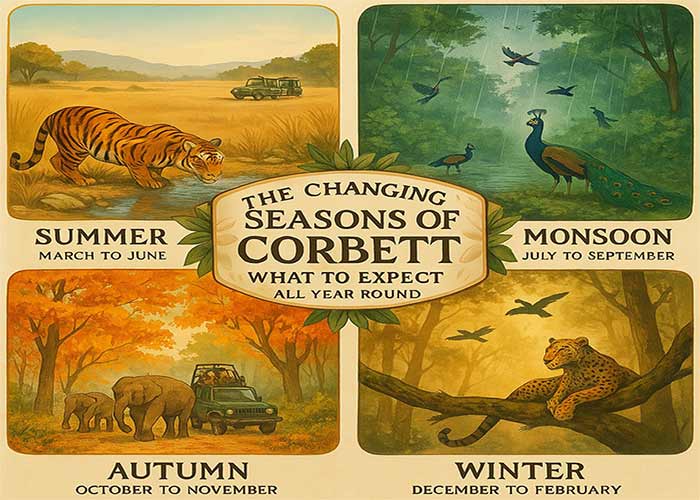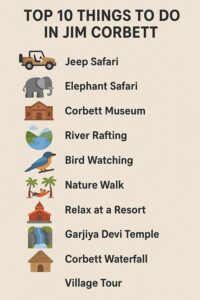Jim Corbett National Park, nestled in the picturesque foothills of the Himalayas in Uttarakhand, is not just India’s oldest national park it’s a vibrant, ever-changing wilderness that offers something unique in every season. Established in 1936, Corbett is a sanctuary where nature thrives in its purest form, and where each shift in weather brings new sights, sounds, and experiences.
Whether you’re a passionate wildlife enthusiast, a nature lover seeking peace, or a casual traveler looking for a refreshing escape, understanding how Corbett transforms throughout the year can help you make the most of your visit. From sun-drenched summer safaris to misty winter mornings and lush monsoon greenery, every season paints a different picture of the park’s rich biodiversity.
Let’s take a journey through the seasons and explore what Jim Corbett National Park has to offer all year round.
Summer (March to June): The Prime Time for Wildlife Sightings
Summer in Jim Corbett National Park is marked by hot and dry weather, with temperatures ranging from 25°C to 40°C. While the heat can be intense during midday, this season is considered the best time for wildlife enthusiasts to visit the park.
What Makes Summer Special?
As water sources begin to dry up, animals are drawn to the remaining rivers, ponds, and watering holes. This natural behavior increases the chances of spotting tigers, elephants, leopards, deer, and other wildlife during safaris. The vegetation also thins out, making it easier to see animals from a distance.
Safari Experience
- Morning and evening safaris are ideal to avoid the heat and catch animals when they’re most active.
- Zones like Dhikala, Bijrani, and Jhirna are popular for summer safaris due to their open landscapes and high wildlife density.
- Jeep safaris offer flexibility and better chances of sightings.
Photography Tips
- The dry landscape and golden light during sunrise and sunset create perfect conditions for wildlife photography.
- Carry a zoom lens, wear light-colored clothing, and stay hydrated.
Wildlife Highlights
- Royal Bengal Tigers often seen near water bodies.
- Elephant herds moving through grasslands.
- Deer, wild boars, and monkeys are frequently spotted.
- Birds like peacocks, parakeets, and eagles are active and visible.
Travel Tips
- Wear light cotton clothes, a hat, and sunglasses.
- Carry water bottles, sunscreen, and insect repellent.
- Book safaris in advance, as summer is a peak season for wildlife tourism.
Monsoon (JULY TO September)
Temperature Range: 22°C to 30°C
Humidity: High
Rainfall: Moderate to heavy, often unpredictable
Open Zones: Jhirna and Dhela (open year-round)
What Makes Monsoon Special
- Lush Greenery
The forest transforms into a vibrant green paradise. Trees, shrubs, and grasses flourish, creating a dense and refreshing landscape that feels alive and rejuvenated. - Peaceful Atmosphere
With fewer tourists visiting during this season, the park offers a tranquil experience. You can enjoy the sounds of nature raindrops, bird calls, and rustling leaves without the usual crowds. - Birdwatching Bonanza
Monsoon is excellent for spotting a variety of birds, including:- Kingfishers
- Drongos
- Indian Pitta
- Peacocks (often seen dancing in the rain)
- Migratory species that arrive early
- Romantic & Scenic Vibes
Misty mornings, dramatic cloudscapes, and rain-kissed foliage make it a photographer’s dream. The park feels mystical and serene.
Challenges to Keep in Mind
- Limited Safari Access: Most zones (like Dhikala and Bijrani) are closed due to safety concerns and road conditions.
- Slippery Roads: Rain can make trails muddy and difficult to navigate. Safari vehicles may face delays or detours.
- Wildlife Visibility: Animals are more dispersed due to abundant water, making sightings less predictable.
- Leeches & Insects: The wet environment increases insect activity carry repellents and wear protective clothing.
Travel Tips for Monsoon Visitors
- Pack Smart:
- Waterproof jackets and shoes
- Quick-dry clothing
- Binoculars and rain covers for cameras
- Insect repellent
- Stay Flexible:
- Safari timings may change due to weather.
- Be open to enjoying the forest’s ambiance even if sightings are fewer.
- Accommodation:
- Choose resorts near Jhirna or Dhela zones for easier access.
- Some lodges offer indoor nature activities and birdwatching decks.
Why Visit During Monsoon?
If you’re someone who appreciates nature’s quieter, more poetic side, monsoon in Corbett offers a soulful escape. It’s less about chasing tigers and more about immersing yourself in the rhythm of the forest.
Autumn (October to November)
Temperature Range: 18°C to 28°C
Humidity: Moderate
Safari Zones: All zones reopen including Dhikala, Bijrani, Jhirna, Dhela, Durga Devi, and Sitabani
What Makes Autumn Special
- Reopening of All Zones
After the monsoon break, all safari zones become accessible again. Roads are repaired, and the forest is refreshed, offering a full range of safari experiences. - Lush Yet Navigable Terrain
The forest remains green and vibrant from the monsoon rains, but the weather is drier and more stable, making safaris smoother and more enjoyable. - Active Wildlife
Animals begin to move more freely as the forest dries up. You can spot:- Elephants in herds
- Deer, wild boars, and langurs
- Occasional sightings of tigers and leopards
- Crocodiles and gharial near riverbanks
- Bird Activity Picks Up
Resident birds are active, and early migratory species begin to arrive. Great time for spotting:- Crested serpent eagles
- Hornbills
- Woodpeckers
- Barbets
Ideal for First-Time Visitors
- Comfortable Weather: Neither too hot nor too cold—perfect for families, elderly travelers, and children.
- Balanced Experience: A mix of wildlife sightings, scenic beauty, and pleasant climate.
- Great for Nature Walks: Some buffer zones and eco-tourism areas allow guided walks and birdwatching trails.
Photography Highlights
- Golden Light: The soft, golden sunlight filtering through the trees is ideal for landscape and wildlife photography.
- Clear Skies: Post-monsoon clarity enhances visibility and color contrast.
- Dramatic Forest Backdrops: The mix of green foliage and dry patches creates a textured, layered look.
Travel Tips for Autumn
- What to Pack:
- Light jackets or layers for early mornings and evenings
- Comfortable walking shoes
- Binoculars and camera gear
- Sunscreen and hats for daytime safaris
- Booking Advice:
- Book safaris and accommodations in advance—this is the start of the peak season.
- Dhikala zone permits are limited and in high demand.
Why Visit in Autumn?
Autumn is the perfect blend of accessibility, comfort, and wildlife activity. It’s a great time for both seasoned wildlife lovers and first-time visitors to experience the magic of Corbett without the extremes of summer or winter.
Winter in Corbett (December to February)
Temperature Range: 5°C to 20°C
Climate: Cold mornings, pleasant afternoons, crisp evenings
Best Zones: Dhikala and Bijrani (prime for big cat sightings)
What Makes Winter Special
- Misty Mornings & Golden Light
The park is often shrouded in early morning fog, creating a mystical atmosphere. As the sun rises, golden rays pierce through the mist, offering breathtaking views and perfect lighting for photography. - High Wildlife Activity
Animals are more active during the day due to the cooler temperatures. You’re likely to spot:- Tigers and leopards basking in the sun
- Elephants, deer, and wild boars
- Otters and gharial near riverbanks
- Birdwatching Paradise
Winter is peak season for birdwatchers, with a mix of resident and migratory species:- Great hornbills
- Crested kingfishers
- Steppe eagles
- Black storks
- Bar-headed geese and other waterfowl
- Clear Skies & Crisp Air
Visibility is excellent once the morning mist clears, making it ideal for safaris and landscape photography.
Travel Tips for Winter Visitors
- Pack Warm:
- Thermal layers, jackets, gloves, and woolen caps for early morning safaris
- Sunglasses and sunscreen for sunny afternoons
- Safari Strategy:
- Opt for morning safaris for misty landscapes and active wildlife
- Afternoon safaris offer better visibility and warmer conditions
- Accommodation:
- Book well in advance—winter is peak tourist season
- Choose forest lodges in Dhikala for immersive experiences
Photography Highlights
- Tiger sightings in golden light
- Birds in flight against clear blue skies
- Foggy forest trails and sunbeams through sal trees
Why Visit in winter?
Winter offers a balanced mix of wildlife, birdwatching, and scenic beauty. It’s ideal for serious photographers, birders, and anyone looking to experience Corbett at its most peaceful and picturesque.
Best Time to Visit: Based on Your Interests
For Wildlife Sightings (March to June – Summer)
- Why: Dry conditions force animals to gather near water sources, increasing chances of spotting tigers, elephants, leopards, and deer.
- Zones: Dhikala, Bijrani, Jhirna
- Ideal For: Wildlife photographers, safari enthusiasts, adventure seekers
- Tips: Book early morning or late evening safaris for best sightings; carry sun protection and stay hydrated.
For Birdwatching & Pleasant Weather (December to February – winter)
- Why: Migratory birds arrive, and the cool weather makes daytime safaris comfortable.
- Zones: Dhikala, Bijrani
- Ideal For: Birdwatchers, nature photographers, families
- Tips: Dress warmly for early safaris; bring binoculars and bird guides.
For a Peaceful Experience (July to September – Monsoon)
- Why: Fewer tourists and lush greenery create a serene atmosphere.
- Zones: Jhirna and Dhela (open year-round)
- Ideal For: Nature lovers, couples, offbeat travelers
- Tips: Be prepared for rain and slippery roads; focus on birdwatching and forest ambiance.
For Balanced Travel (October to November – autumn)
- Why: All zones reopen, the forest is lush, and the weather is pleasant.
- Zones: All zones (Dhikala, Bijrani, Jhirna, Dhela, Durga Devi, Sitabani)
- Ideal For: First-time visitors, families, casual travelers
- Tips: Great time for nature walks and photography; book safaris early as demand rises.
Final Thoughts
Jim Corbett National Park is a living canvas where nature paints a new masterpiece with every season. From the sun-drenched summer safaris to the misty winter mornings, from the lush monsoon greenery to the crisp charm of autumn each phase reveals a different side of Corbett’s wild soul.
Understanding these seasonal shifts not only helps you plan your visit better but also deepens your connection with the rhythms of the forest. Whether you’re a wildlife enthusiast, a bird lover, a photographer, or simply someone seeking peace in nature, Corbett offers a timeless experience that evolves beautifully throughout the year.
So no matter when you choose to go, you’re not just visiting a park you’re stepping into a story that changes with the seasons, yet always leaves you with unforgettable memories.




